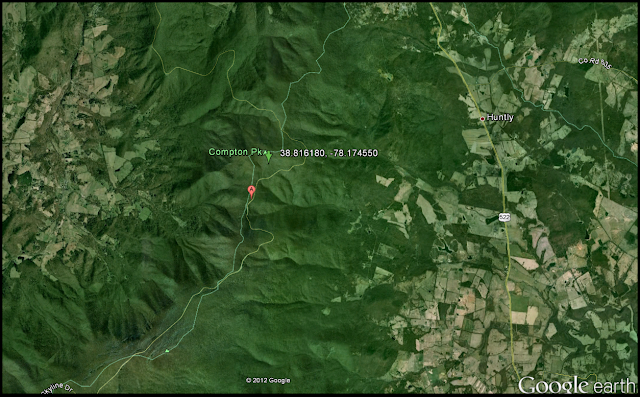Several weeks ago my structural geology class went on a scheduled three day field trip, which had to be cut short due to what turned out to be four inches of snow. This trip was started just like the others with a rendezvous time of 9 o'clock in the morning at George Mason University in Fairfax. The class filled out the usual insurance paperwork, loaded the vans and started out west towards the Blue Ridge and the Valley and Ridge provinces.
As mentioned above the trip was cut short but we did make four stops that deserve to be analyzed.
The first day of adventure started off a little foggy with a high around 70 degrees Fahrenheit and a lot of enthusiasm.
Garth Run is located in a high strain zone of basement rock, which is indicated below in map view.
Garth Run was the most complicated part of the trip, which was frustrating at first because it was so complicated, however this difficult outcrop did open us up to asking the right questions. The predominant rock type was blue quartz which is indicative of the Grenville Basement province. The Grenville was formed during the rifting of the proto-atlantic ocean roughly 1.1 billion years ago. These rocks were then metamorphosed again during the closing of the proto-atlantic ocean and several other tectonic mountain building events. The last tectonic event was after the Mesozoic rifting, which occurred around 210 million years ago.
 |
| Picture illustrating the location of Garth Run in Virginia - please note the red pin for placement. Picture from Google Earth. |
The Grenville orogeny eroded away which allowed for deposition of lava and other sediments on top of the basement complex. The following tectonic event was termed the Alleghanian which took place around 200 - 300 million years ago. During this event the African and the North American plates were converged on one another which left distinct areas of stress or shear zones. This is why geologist consider Garth Run to be a shear zone. For the non-geologists a shear zone is an area were faulting takes place underground and because it is underground (high pressure) the faults are not brittle but ductile in nature. This usually occurs at depths greater than 15km. Myolonites are distinctive rock types as well as ultramylonites that were present and indicative ductile deformation.
While taking in the structural geology of Garth Run I noticed some foliation, boudinage, joint surfaces with different foliation angles and differential erosion. After taking careful consideration to all of these primary and secondary structures it was determined that this was a very large area of anastomosing. Anastamosing refers to the shape of foliation or braided pattern. In geology what is in the very very small can also be seen in the very very large and thus by looking at the smaller structures like boudinage we can essentially see the larger structures - anastomosing. The boudins are quartz and feldspar while the outer edges are microlithon, which is the axial plane of cleavage.
 |
| Left: Black line indicates the C fabric while the blue line represents the S fabric in the foliation. Right: Same picture as the left however zoomed in more closely to show the two different orientations of foliation near this joint surface. This is indicative of anastomosing. Picture location on the far right courtesy of Jodi Deprizio. |







